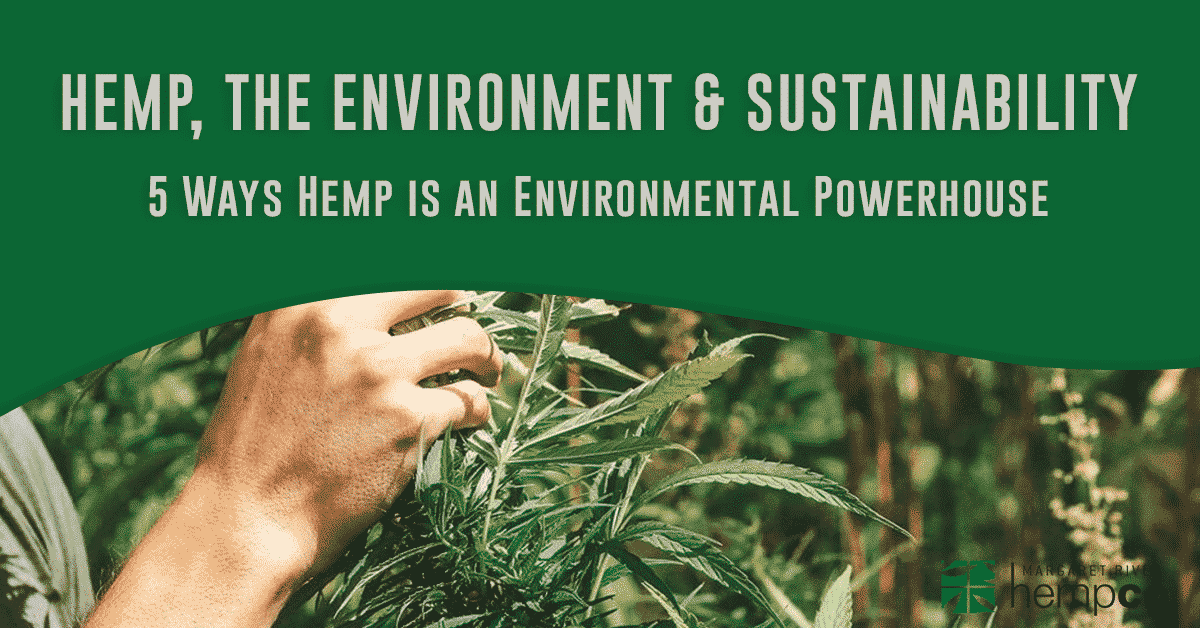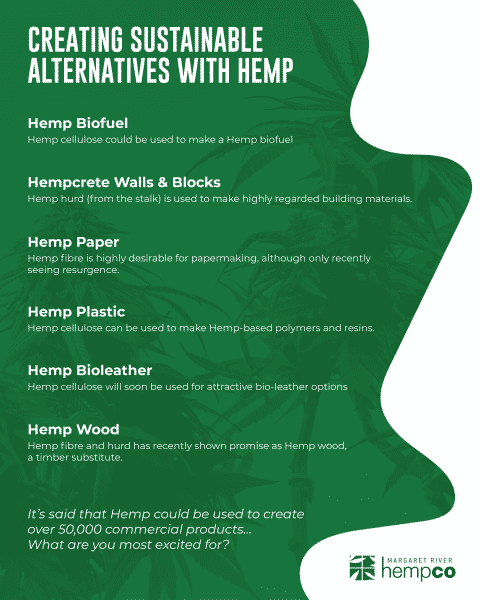
Hemp advocates have been continually teaching people that hemp has various benefits to man and the environment, which leads to question how much truth is behind the statement. Is Hemp Sustainable?
It has been challenging to verify these claims for a long time due to the restriction in hemp's farming, distribution, and usage. However, the ease of the limitation on hemp in several countries globally has allowed scientists to test these theories.
Hemp has significant positive impacts on the environment for a variety of reasons. From cleaning the soil to removing Co2 from our atmosphere & beyond, there is so much to talk about regarding the ecological benefits of growing and utilising Hemp.
How many environmental benefits can you name off the top of your head?
This week we’re taking a deep dive into the future roles of Hemp in sustainability & regeneration. Read on to learn more!
Carbon sequestration is one of the most exciting functions of Hemp. Carbon sequestration is a process that involves trapping carbon dioxide in the soil so that it is not released into the atmosphere. Carbon dioxide is an air pollutant that has adverse effects on health.
Moreso, civilisation has created several channels that carbon dioxide is released into the atmosphere. Carbon sequestration may be biological, physical, geological, chemical, direct, or indirect.
According to research from Cambridge University, Hemp farming is more effective in trapping carbon dioxide than regular trees.
In 2019, Catherine Wilson, during the European Industrial Hemp Association, emphasised that hemp absorbs more carbon from the moment it is planted- which is instrumental in reducing the greenhouse effect in the environment.
Hemp was once an approved crop in the Australian government's late ‘carbon farming incentives & carbon credit system’. This incentivised farmers to grow approved plants recognised for their significant absorption of co2 per hectare.
Bioremediation is the process in which living things are used in cleaning the soil, in this case, hemp. Hemp is known for its ability to clean up polluted soil. It has been used in several contamination sites where the ground has been rendered useless for agriculture.
Several farmers have embraced hemp farming in Italy to nourish and decontaminate the soil. Crops weren't growing correctly, and those that did were still contaminated with heavy metals and toxins from the pollution.
However, in 2012, Hemp farming changed the general narrative. One farmer, in particular, has a remarkable story about how growing Hemp on his land removed contaminants from a nearby steel refinery, which you can read about here.
Chernobyl is another excellent example of how hemp cleans the soil through bioremediation. In 1986, Chernobyl experienced a nuclear disaster that rendered lands infertile and unsafe farming. In 1998, hemp farming began in Chernobyl and had proved instrumental in absorbing contaminants from the soil.
Hemp's deep taproot naturally turns over the soil so that the growing solution moves throughout the top layer of sediment. This keeps soil enriched with various nutrients and co2.
Hemp has very long taproots, making it rather drought-resistant as it can further absorb soil water and nutrients. This eliminates competition for water and nutrients between hemp and other crops.
Additionally, the biomass left in the field & leaf fall infuses much-needed nutrients back into the soil, such as nitrogen. This prepares the ground for the next crop.
Hemp improves soil structure and texture with its elongated tap root system. It is capable of loosening compacted soil to improve aeration and biomass. Furthermore, it absorbs toxins from the earth, essentially serving as a natural soil cleanser.
The hemp plant reduces the growth of weeds (and the irony of that is fantastic). The leaves are broad, thus preventing sunlight from getting to smaller weeds.
This is a natural and effective strategy of preventing weed influx in farmland without using herbicides. The hemp plant produces coumaric, caffeic, and benzoic acids that inhibit the growth of weeds. In addition, it is pest resistant, so this protects the farmland from pest invasion.
Hemp is a "low-maintenance" crop because it is not highly nutrient demanding. The taproot can absorb nutrients from a deep level of the soil. Therefore, it is best to plant hemp before grains, root and tuber crops (onions, potatoes), vegetables, and grass.
The hemp plant is instrumental in preserving bees. Bees are essential pollinators in crop farming. In addition, they are the natural source of honey for humans. Unfortunately, however, there has been a recent decline in the population of bees.
Hemp pollen can save the bees by acting as an off-season food source in seasons when there is no nectar in the air. A recent study shows that the flowers of hemp can attract several species of bees. The study also revealed that bees preferred hemp flowers to other plant flowers.
Therefore growing hemp could help sustain our dwindling bee population. Planting hemp also is a method of reducing pesticides that may pose a danger to bees. Hemp is pest resistant, hence a good option for maintaining the population of bees on your farm.
There are a number of products that Hemp offers much more eco-friendly solutions to. When it comes to biofuels and plastics, is Hemp sustainable?
It certainly is.
Some say that there are over 50,000 commercial products that you can make from Hemp - all of them being more eco-friendly than their traditionally manufactured counterparts.

As we move into an accelerated pace of research & development, we anticipate that more innovators in the space will step up and begin testing many of the applications mentioned here. While some are already in production, not all of them are at scale yet - and that's when things are going to get very exciting.
Here are some of our favourite eco-friendly Hemp alternatives.
Have you encountered any of these?
Hemp Biofuel is a potential future alternative for fuel, but the demand and scale still aren't quite there. Hemp biodiesel and ethanol (or methanol) are the two main types of hemp biofuel. Hemp is a cost-effective source of energy because it is easy to extract.
Ethanol is a constituent of gasoline. On the other hand, methanol is majorly used in racing cars globally. Every part of the hemp plant can be converted into ethanol or methanol through processes like cellulolysis and pyrolysis.
Hemp biodiesel, much like vegetable oil, can be derived from Hemp Seed Oil with the correct process & engine conversion. It is a biodegradable replacement for diesel. In addition, it is safe to handle, store, and transport.
Furthermore, it is less flammable than regular diesel from petroleum, which is an excellent benefit. Currently, it isn’t commercially viable due to costs, but who knows what the future might hold!
Hemp shivs are a by-product of fibre processing you can use to make Hempcrete. Hempcrete is a sustainable, eco-friendly, highly durable building material made from the hemp plant's stalk mixed with mud cement or lime.
Hempcrete is lightweight and contains a high amount of silica, allowing it to bond with lime. Furthermore, it is a carbon-negative material that absorbs carbon dioxide from the atmosphere.
Calcium hydroxide is the binding agent used for hempcrete and lime. Therefore, it absorbs carbon dioxide from the atmosphere to produce calcium carbonate.
Moreover, hempcrete allows for the conservation of resources as it requires less water than traditional concrete for curing. In addition, it maintains a comfortable internal environment due to its thermal insulation properties.
Finally, it is resistant to earthquakes, mould, and pests, making it an excellent building material.
Sustainable material reduces the amount of carbon dioxide in the atmosphere. Hemp is a high-yield plant that produces more on less land.
Growing the plant uses less water than other textile plants like cotton. In contrast to the cotton plant, hemp does not require insecticide or pesticides, protecting the soil from pollution.
Furthermore, hemp materials are more durable than other materials. They have the unique ability to block Ultraviolet rays from the sun.
In addition, hemp fabrics are hypoallergenic, making them suitable for sensitive skin. Finally, the biodegradable nature of hemp materials ensures they are not a source of pollution when you dispose of them.
Hemp paper is easier to produce because it has less quantity of lignin. The chief ingredient in the paper is Hemp-derived cellulose. Hemp has 85% cellulose, while wood has 30%.
Paper from wood requires chlorine bleaching to produce a bright paper. This process is not eco-friendly because toxic dioxin is released into the atmosphere. However, hemp paper does not require chemical bleaching.
Before the ban on hemp farming, manufacturers and consumers preferred hemp paper because of its durability. The colour and texture last longer than wood-based paper. You can recycle hemp paper about eight times.
However, you can only recycle tree-based paper about three times. The adoption of the hemp plant in papermaking will also significantly reduce deforestation, which has severe effects on the environment.
Hemp stalk matures within four months, whereas trees may take between 20-80 years. Additionally, it can produce more than 2x the amount of paper.
Hemp grows very fast; hence, it is an alternative to sustainable bio-plastics. Hemp plastics are made from non-toxic and biodegradable fibres, making them an excellent choice.
Plastic may require between 500-1000 years to degenerate, which is not sustainable for the environment. Regular plastic is toxic to the human body and the environment. The hemp plant absorbs carbon dioxide, which is locked in the bio-plastic.
The amount of waste generated from plastic is on the rise, and it has a significant effect on the pollution of water bodies. In addition, marine life may ingest pieces of plastic, leading to poisoning, reducing wildlife.
Hemp plastic is so versatile that we can make just about any plastic product. Another reason hemp plastic is an excellent choice is that it is safe for the environment.
Unlike regular plastics, manufacturing hemp plastic absorbs carbon dioxide and does not leave any toxic residue. In addition, hemp plastics are lightweight yet more robust than traditional plastics.
Hemp wood is a sustainable alternative to regular wood for several reasons. First, hemp wood matures within a few months (6 months), while trees require several years to produce quality wood.
The hemp seed is planted to absorb carbon dioxide from the atmosphere while making oxygen. Secondly, hemp wood is biodegradable, recyclable, and reusable. The production of hemp wood requires less energy expenditure.
Formaldehyde is not used in Hemp wood production, so it does not emit VOCs. Furthermore, it has excellent insulating properties. Hemp wood has a natural resistance to pests and is 20% more stable than oak wood.
Several individuals have reservations about leather because it is from animals. However, hemp is a sustainable alternative for making 100% cruelty-free hemp leather.
This leather does not require any chemical processing, as seen in leather production from animal skin. Hemp leather is customisable and has various uses such as clothing, leather for furniture, vehicles, etc.